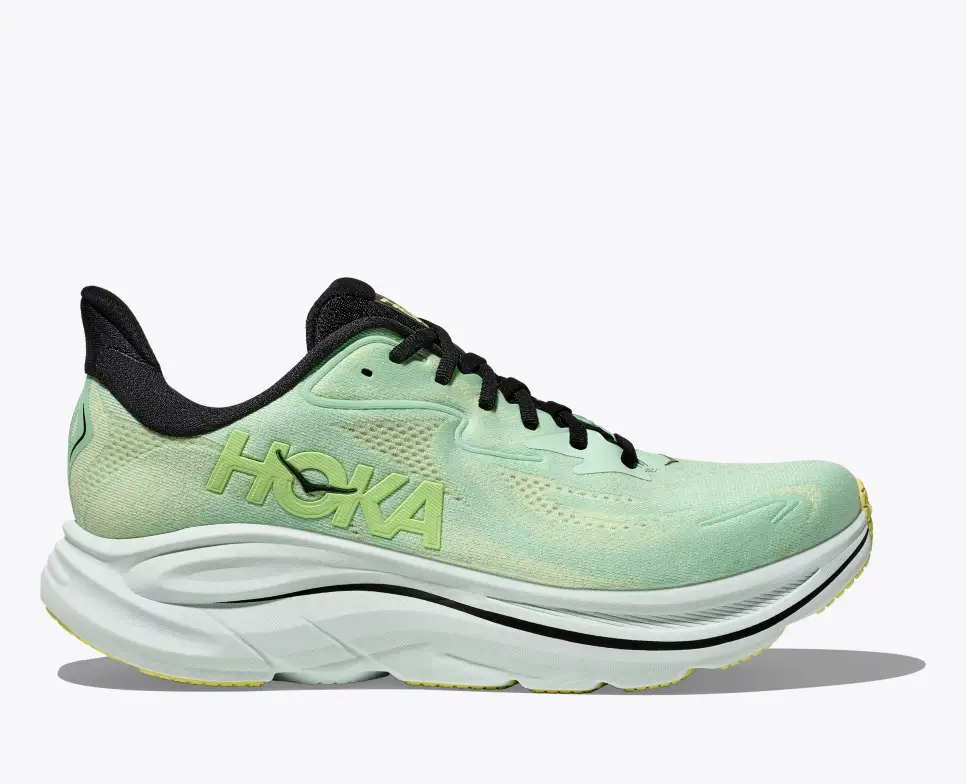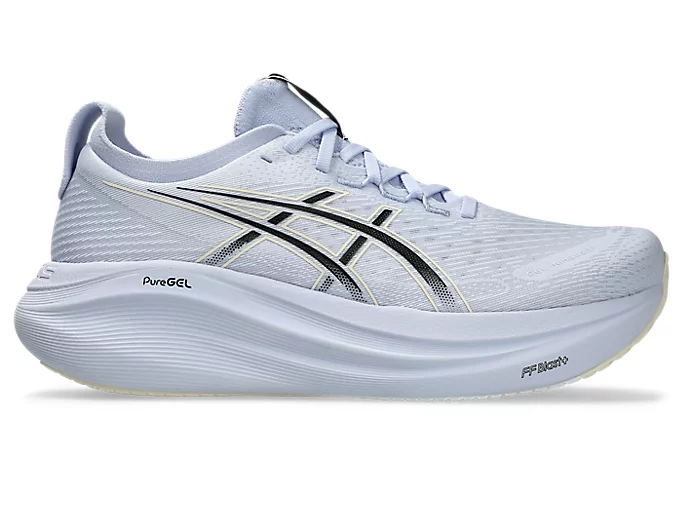Two icons of the daily-trainer world, ASICS Gel-Nimbus and HOKA Clifton, are back with fresh updates for 2025. Both promise next-level cushioning, smoother transitions, and lighter rides. But which pair actually deserves your long-run loyalty?
Let’s break down the Gel-Nimbus 27 vs Clifton 10, focusing on fit, ride, durability, and real-world performance for Australian runners. Runners often struggle to choose between ASICS and HOKA, two premium brands that excel in comfort. These brands deliver exceptional cushioning but approach plush comfort differently. The ASICS Gel Nimbus 27 comes with a $260 AUD price tag and boasts a 43.5mm heel stack with FF Blast+ Eco midsole technology. The HOKA Clifton 10 matches this with its 42mm heel stack and CMEVA cushioning.
Choosing between HOKA and ASICS becomes easier once you understand their strengths. The Nimbus 27’s softer, plush ride makes it perfect to handle uptempo runs and long, comfortable miles. The Clifton 10 proves itself as a great companion to recovery runs, walking, or standing. This piece breaks down everything about these premium runners to help you find your perfect match. You’ll learn about stack heights, sizing differences, and even weight comparisons – the ASICS weighs 307g for men, while HOKA offers a lighter build.
Quick Specs Comparison
|
Feature |
ASICS Gel-Nimbus 27 |
HOKA Clifton 10 |
|
Weight (Men’s) |
~305 g / 10.8 oz |
~278 g / 9.8 oz |
|
Drop |
8 mm |
8 mm |
|
Stack Height |
43.5 mm / 35.5 mm |
42 mm / 34 mm |
|
Midsole Tech |
FF Blast™ Plus Eco + PureGEL™ |
CMEVA foam + Meta-Rocker geometry |
|
Upper |
Engineered Jacquard Mesh (softer collar, roomier toe box) |
Re-designed Jacquard Knit upper (wider forefoot than Clifton 9) |
|
Ride Feel |
Plush, stable, high impact protection |
Balanced, light, responsive roll |
|
RRP (AU) |
≈ $259 AUD |
≈ $239 AUD |
|
Where to buy |
Cushioning and Midsole Feel
Premium running shoes are built on their midsole technology. This aspect makes the Asics vs Hoka comparison really fascinating.
Foam Composition: FF Blast+ Eco vs CMEVA
ASICS uses their own FF Blast+ Eco foam – an updated formula that gives you a bouncy yet plush feel under your feet. This eco-friendly material is lightweight and returns energy well while absorbing shock effectively. HOKA takes a different approach with its CMEVA (Compression Moulded EVA) foam. Both brands offer premium cushioning tech, but HOKA’s design creates a firmer, more responsive sensation under your feet.
Stack Height: 43.5mm vs 42mm Heel
These competitors have a small but noticeable difference in stack height. The ASICS Gel-Nimbus 27 comes with a 43.5mm heel stack and 35.5mm forefoot stack. This creates a thick cushioning layer between your foot and the ground. HOKA’s models typically have a heel height of approximately 42 mm. They still give you great cushioning with just a bit less material.
Drop and Impact: 8mm vs 8mm
Both brands feature an 8mm heel-to-toe offset in their flagship models. The feel is quite different, though. ASICS pairs this 8mm drop with their GEL technology to absorb shock better during heel strikes. HOKA’s approach focuses on smooth transitions as you move through your stride.
Softness vs Responsiveness: Plush vs Firm Ride
The biggest difference between these premium runners comes down to how they feel. ASICS provides a softer, plusher experience that works well for long runs. The Nimbus 27 bounces nicely and feels gentle on tired legs. HOKA shoes feel firmer and more responsive. Many runners love this balance for daily training and recovery runs. The CMEVA foam hits a sweet spot – firm enough to give feedback but cushioned enough to stay comfortable.
Your choice between Asics vs Hoka running shoes might depend on what you value more – plush softness or responsive firmness in your everyday trainers.
Stability and Ride Dynamics

Your comfort and performance in the Asics vs Hoka matchup depends heavily on how a shoe guides your foot through each stride.
Rocker Geometry: Later-stage vs Early-stage
The main difference in ride dynamics comes from their rocker designs. HOKA uses an Early-stage Meta-Rocker that starts near the midfoot (about 60% of shoe length) to create smooth heel-to-toe transitions. ASICS takes a different approach with a Later-stage rocker starting closer to the toes (around 75% of length) to give extra stability. HOKA’s design makes the ride feel more guided throughout, while ASICS delivers a traditional feel with strong toe-off support.
Heel Bevel and Transition Smoothness
ASICS uses a sharper, more defined heel bevel that helps with quick transitions. Their 4D Guidance System has an improved heel bevel designed specifically to control landings and make transitions smoother. HOKA takes a different path with their “bucket seat” heel system, which works like a race car seat to cradle the heel stably without losing cushioning.
Support Features: Sidewalls and Sole Flare
Both brands add stability features while keeping comfort intact. HOKA builds sidewalls on both medial and lateral sides with subtle sole flare in the forefoot to create a broad, stable base. ASICS depends on a wider platform, carefully shaped midsole, and supportive sidewalls. These features work great for overpronators by stopping excessive inward foot rolling.
Best Use Cases: Recovery vs Tempo Runs
Stability features directly shape how you should use these shoes. HOKA shines during recovery runs and walking with stable comfort, but lacks the responsiveness needed for speed work. ASICS shows more versatility and handles both easy miles and tempo sessions thanks to its firmer, more responsive ride. ASICS weighs 307g compared to HOKA’s 249g, giving it a more substantial feel underfoot.
Fit, Upper, and Sizing
The design philosophy of the upper shows a significant difference in the Asics vs Hoka debate.
Toe Box Width: Tapered vs Roomy
ASICS shoes come with a more tapered fit, which runners notice most in the forefoot. HOKA used to make narrower toe boxes, but their newer models give you wider forefoot space. Men who need more toe room can choose ASICS’ wide (2E) and extra-wide (4E) options.
Tongue Design: Gusseted vs Non-Gusseted
HOKA models come with padded, gusseted tongues attached to both sides of the shoe. This design keeps debris out and helps lock your foot in place. ASICS takes a different approach with thinner, gusseted tongues that protect your feet without adding bulk.
Heel Collar Padding and Entry
ASICS adds extra heel collar padding and includes a practical pull tab that makes the shoes easier to put on. Both brands use moderately stiff heel counters. Runners with heel bursitis or Achilles issues should keep this in mind.
Asics vs Hoka Sizing: Width and Volume Options
ASICS tends to run half a size smaller than HOKA. Many runners need to size up. Both brands use standard widths – D for men and B for women. HOKA’s higher volume upper works well if you need more instep space. ASICS delivers a more secure midfoot fit.
Performance in Daily Use
Real differences between ASICS and HOKA become clear after you’ve logged some miles in these premium runners.
Walking and Standing Comfort
HOKA shoes make excellent all-day footwear that gives exceptional comfort to people who stand or walk a lot. Their plush cushioning creates a “walking-on-clouds” feeling – perfect for retail workers, healthcare professionals, or anyone who needs lasting comfort. ASICS shoes provide firmer support that works better for structured walking workouts rather than standing all day.
Running Versatility: Easy Runs to Long Runs
ASICS shows great versatility at different running speeds. The Nimbus 27’s responsive midsole handles both long, steady runs and faster-paced sessions well. HOKA models do their best work during recovery runs and easy miles. Some runners say they have trouble picking up the pace in HOKAs, which makes them less ideal for speedwork.
Durability Over 300km+
These brands last longer than most others. ASICS suggests getting new shoes after 450-500km. HOKA models often go beyond this range, and their trail running shoes can reach 500km before needing replacement. Some runners notice HOKA’s midsole starts to flatten slightly after about 100km.
Weight Comparison: 307g vs 249g
The weight gap tells a story: ASICS Gel-Nimbus 27 comes in at 307g while HOKA stays lighter at 249g (men’s size 9). You’ll feel this 58g difference on longer runs. ASICS makes up for its extra weight with better stability and structure. The heavier build helps ASICS handle different speeds well, even with the added weight.
Comparison Table
|
Feature |
ASICS (Gel-Nimbus 27) |
HOKA (Clifton 10) |
|
Technical Specifications | ||
|
Price |
$260 AUD |
Not mentioned |
|
Weight (Men’s) |
307g |
249g |
|
Heel Stack Height |
43.5mm |
42mm |
|
Heel-to-toe Drop |
8mm |
8mm |
|
Cushioning Technology | ||
|
Midsole Material |
FF Blast+ Eco |
CMEVA |
|
Cushioning Feel |
Soft and plush |
Firm and responsive |
|
Design Features | ||
|
Rocker Design |
Later-stage (75% of length) |
Early-stage (60% of length) |
|
Toe Box Design |
Tapered fit |
Spacious forefoot |
|
Tongue Design |
Thin, gusseted |
Padded, gusseted |
|
Sizing Fit |
Runs half size smaller |
True to size |
|
Performance | ||
|
Best Usage |
Uptempo runs, long distances |
Recovery runs, walking, standing |
|
Durability |
450-500km recommended |
Over 500km (trail versions last longer) |
|
Stability Features |
Wide platform, sculpted midsole |
Sidewalls, broad base |
|
Transition Feel |
Quick with defined heel bevel |
Smooth guided transitions |
Conclusion
ASICS and HOKA each have their own take on what makes the perfect running shoe. Both brands deliver premium comfort but take very different paths when it comes to cushioning and design.
ASICS shines for runners who want a plush, bouncy feel that works at any pace. The Gel-Nimbus 27’s extra weight pays off with better stability and responsiveness. You can use it for long, easy miles or pick up the pace when needed. HOKA takes a different approach with its firmer CMEVA foam and early-stage Meta-Rocker. These shoes work great for recovery runs, walking around, or jobs where you’re on your feet all day.
The fit and feel between these shoes couldn’t be more different. ASICS tends to run half a size small with a narrower forefoot. HOKA gives you more room to spread out with a higher volume upper. Their approach to stability is just as different – HOKA uses sidewalls and a wide base, while ASICS goes with a broader platform and sculpted midsole.
HOKA’s lighter 249g build might catch some runners’ eyes compared to ASICS’ 307g weight, but this 58g difference comes with its own give and take. Your choice between these premium runners should focus on what you need rather than just numbers on a scale.
Your perfect running shoe comes down to your running style, where you run, how hard you train, and what feels good on your feet. ASICS excels at versatility and plush comfort. HOKA stands out with unique stability features and all-day comfort. Both shoes are excellent – they just serve different needs. Pick the one that lines up best with how you run.
